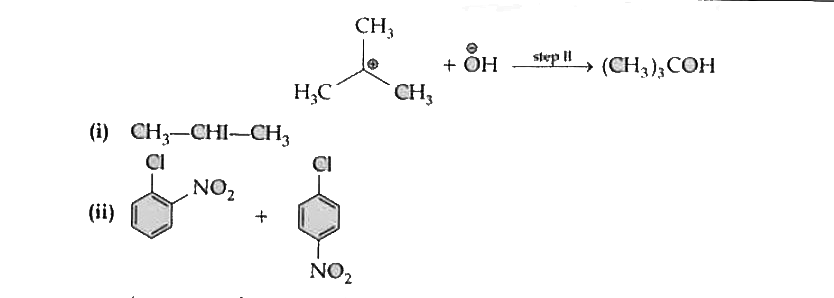(a) Explain SN1 mechanism for the conversion of tertiary butyl bromide to tertiary butyl alcohol.
(b) Complete the following reactions :
(i) CH3−CH=CH2+HI→
(ii) 
(iii) CH3CH2BrAgCN−−−−−−→Aq EthanolSolution in Kannada
In this step, polarised C Br bond undergoes cleavage to produce a carbocation and a bromide ion.

In this step, carbocation is attacked by nucleophile to form the product (formation of C-OH bond).

(iii) CH3CH2NC
(a) Conversion of tertiary butyl bromide to tertiary butyl alcohol using SN1 mechanism occurs as follows :
Step - 1 : Formation of carbocation :
CH3−CH3∣C∣CH3−Br(tertiary butyl bromide)slow step−−−−→CH3−CH3∣C+∣CH3(carbocation)+Br−
Step - 2: Fast step and formation of racemic mixture of product :
CH3−CH3∣C+∣CH3+OH−(Nucleohile)fast−−→CH3−CH3∣C∣CH3−OH(tertiary butyl alcohol)
(b) (i) This is an example of unimolecular nuclephile substitution reaction i.e. rate ∝ [substrate]
(b) (i) CH3−CH=CH2+HI→CH3−CH∣I−CH3
(ii) 
(iii) CH3.CH2.BrAgCN−−−−→aq.thanolCH3.CH2.NC(etyl isocynaide)+AgBr
Topper's Solved these Questions
Similar Questions
Write the equations for the reactions involved in the leaching of alumina from bauxite ore.
View SolutionName the law behind the dissolution of CO2 gas In soft drinks under high pressure.
View SolutionThe experimental value for the molar mass of a non-volatile solute is twice the theoretical value. What is the Van't Hoff factor for the solute?
View SolutionCH_(3)CH_(2)underset(Br)underset(|)(CH)CH_(2)CH=CH_(2) overset("alcoholic KOH")rarr A (predominant) A is
View SolutionGiven the IUPAC names of the following haloalkanes and label them as primary (1∘), secondary (2∘), or tertiary (3∘)
(i) tert-pentylioddie
(ii) CH3CH2C∣ClHCH3∣CHCH3
(iii) Isobutyl chloride
(iv) n-butyl bromide
(v) CH3CH2−CH3∣C∣Br−CH2−CH3∣CH−CH3
Isopropyl chloride
Strategy: For common names, first write the sturucture of the alkyl group, and then attach the halgon atom to the free valency.
View SolutionClassify the following as primary, secondary and tertiary alcohols: (i) CH_(3)-overset(CH_(3))overset("| ")underset(CH_(3))underset("| ")(C )-CH_(2)OH (ii) H_(2)C=CH-CH_(2)OH (iii) CH_(3)-CH_(2)-CH_(2)-OH (iv)
View SolutionClassify the following into primary, secondary and tertiary alcohols (i) CH-underset(CH_(3))underset(|)overset(CH_(3))overset(|)(C)-CH_(2)OH , (ii) H_(2)C=CH-CH_(2)OH , (iii) CH_(3)-CH_(2)-CH_(2)OH
View Solutionनिम्नलिखित अभिक्रियाओं के प्रमुख उत्पाद कि संरचना लिखिए -
(i) CH3CH2CH2Cl+NaIAcetone−−−−−−→Heat
(ii) (CH3)3CBr+KOHEthanol−−−−−−→Heat
(iii) CH3CH(Br)CH2CH3+NaOHWater−−−→
(iv) CH3CH2Br+KCNAq. ethanol−−−−−−→
(v)C6H5ONa+C2H5Cl→
(vi) CH3CH2CH2OH+SOCl2→
(vii) CH3CH2CH=CH2+HBrPeroxide−−−−→
(viii) CH3CH=C(CH3)2+HBr→
View Solutionनिम्न अभिक्रिया को पूर्ण कीजिए -
CH3CH2CH2BrKOH(aq)−−−−−−→AΔ−−→B
View SolutionWrite equations for the steps in S_(N)1 mechanism of conversion of tertiary butyl bromide into tertiary butyl alcohol.
View SolutionThe reaction shows which of the following mechanisms?
CH3−C∣CH3H−ClKOH(aq)−−−−−→CH3−CH∣CH3−OH+Cl−
View SolutionComplete the following reactions: (i) CH_(3)-CH_(2)-O-overset(CH_(3))overset("| ")underset(CH_(3))underset("| ")"C "-CH_(3)-HI overset("Heat")rarr (ii)
View SolutionIdentify the most suitable reagent for the following conversion ? CH_(3)-CH_(2)-underset(Br)underset(|)(CH)-CH_(3)overset("Reagent")(rarr)CH_(3)-CH=CH-CH_(3)
View SolutionWhich alkyl halide from the following pairs would you expect to react more rapidly by SN2 mechanism ? Explain your answer.
CH3CH2CH2CH2 or CH3CH2−C∣BrH−CH3
(ii) CH3CH2C∣BrHCH3 or H3C−CH3∣C∣CH3−Br
(iii) CH3C∣CH3HCH2CH2Br or CH3CH2C∣CH3HCH2Br
View SolutionClassify the following as primary, secondary and tertiary alcohols:
(i) CH3−CH3| C| CH3−CH2OH (ii) H2C=CH−CH2OH
(iii) CH3−CH2−CH2−OH
(iv)

View SolutionClassify the following as primary alcohols, secondary alcohols and tertiary alcohols.
(i) CH3−CH3∣C∣CH3−CH2OH
(ii) H2C=CH−CH2OH

(iv) CH3−CH2−CH2−OH
View Solution